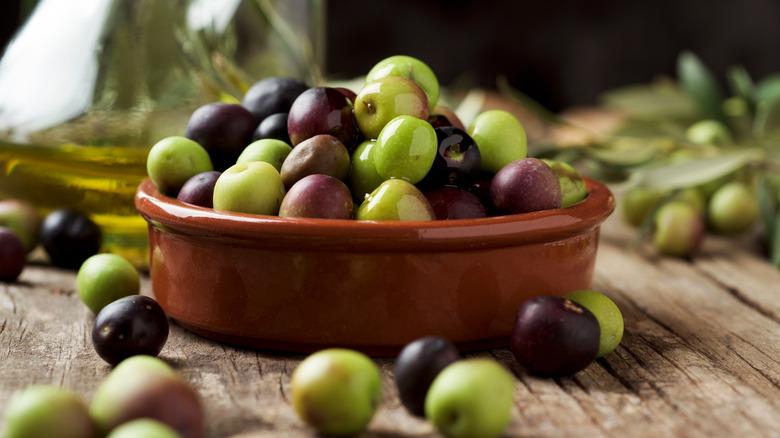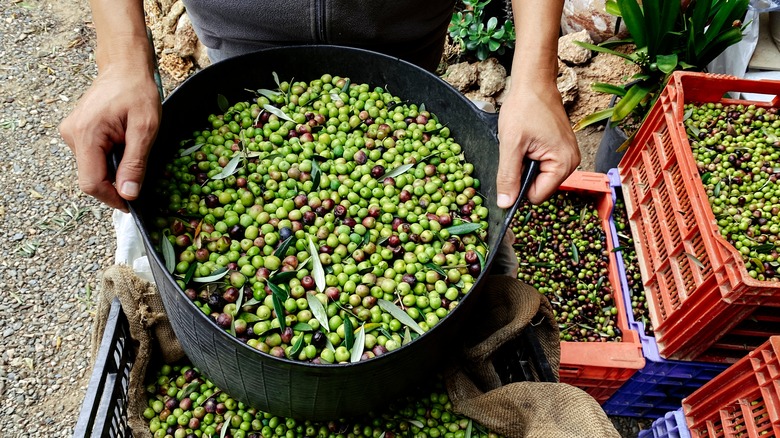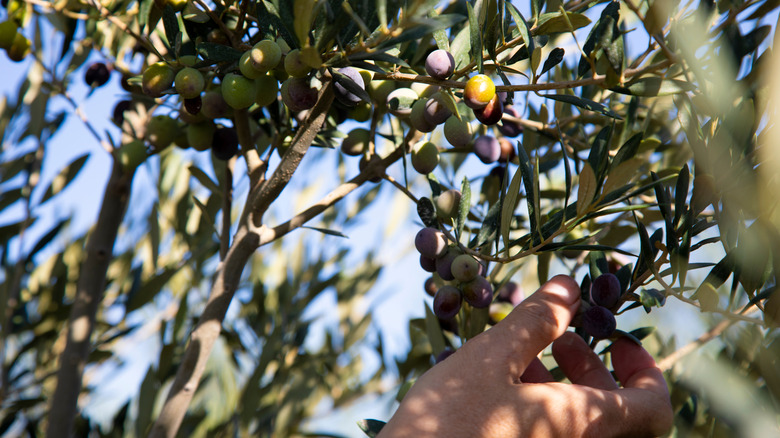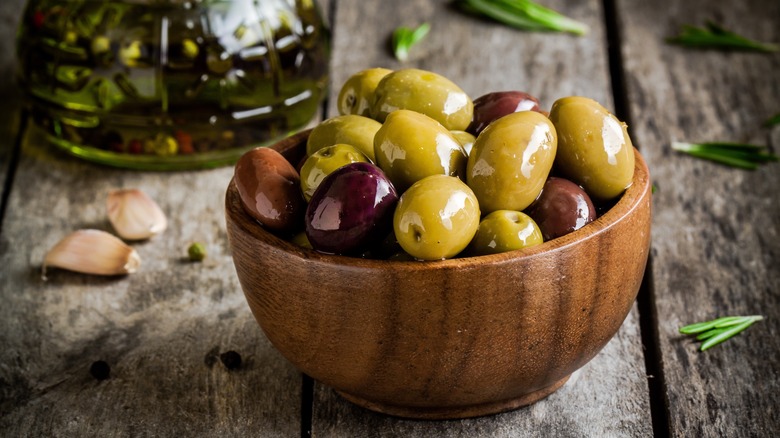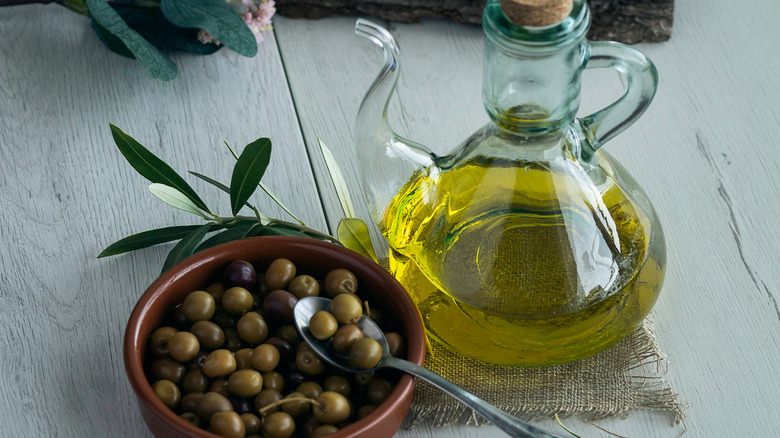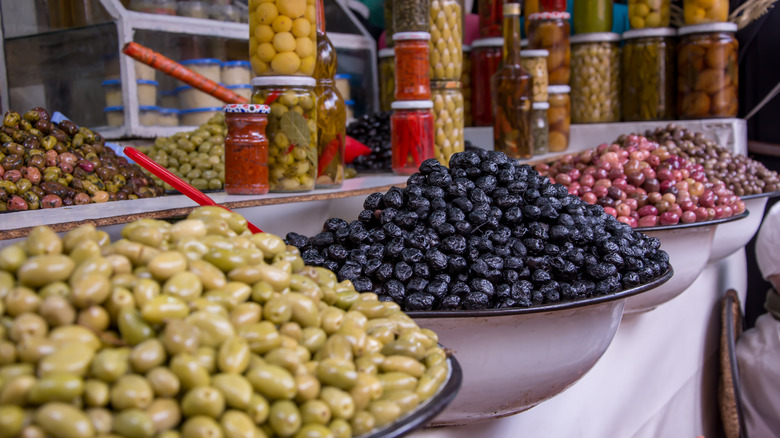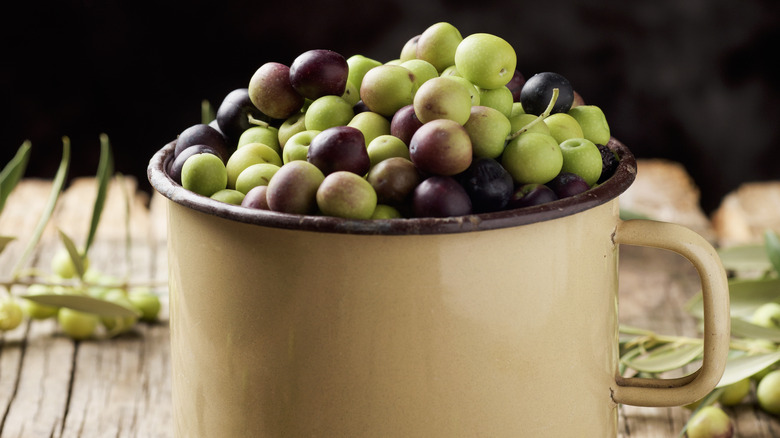Arbequina Olives Pack An Oversized Punch Of Flavor
Olives are a staple of Mediterranean cuisine, from Greece, Italy, Spain, and other countries throughout the region. It's believed that olives became a domestic, widely cultivated fruit anywhere from 6,000 to 8,000 years ago, according to Live Science. Since then, they've been eaten on their own, added to various dishes, and pressed to create olive oil.
Olives are a major cultural and historical staple along the Mediterranean coast and are even present in ancient religious and spiritual texts and stories. DeLallo states that there are at least 500 varieties of edible olives, from lighter green varieties to darker black olives, each with its own flavor profile, texture, and means of growing, harvesting, and curing. One of the most popular olives for olive oil production, as well as eating, is the Arbequina olive, which hails from Spain (via Olive Oil Times). Keep reading to learn all about the Arbequina olive — where it comes from, what it tastes like, how to cook with it, and more.
What are Arbequina olives?
According to Olive Oil Times, the second most popular olive for olive oil production is the Arbequina olive. The fruit is native to Spain, and more specifically, Catalonia. It's also a delicious olive to eat by itself, with a mild, more palatable flavor for olive lovers and newcomers to the cured fruit alike.
It's a type of black olive that's often identified as being very meaty in texture, per Olive Tree Farm. Known botanically as Olea Europaea 'Arbequina,' the olive comes from a slow-growing, sun-loving tree. The Olive Oil Times reports that 78% of the 17,000 acres of olive trees in California are Arbequina olive trees. The region it natively hails from in Spain also produces 10% of all olive oil in the world. It's an incredibly important and versatile fruit, producing both olive oil and table olives alike.
How are Arbequina olives grown?
While Arbequina olives are most commonly grown in Catalonia, Spain, as well as California, they can be grown in your own backyard. According to Stark Bro's, Arbequina olive trees are very easy to grow in containers, keep outdoors in the warmer months, and bring inside in the cooler months. Or, if you live in warmer climates (USDA hardiness zones 8 through 11), you can grow them in-ground year-round, per FastGrowingTrees.com.
In ideal climates, the olive tree can grow as tall as 15 feet, and live 100 years or more. They're also quite low maintenance. All they need is well-draining soil, whether in the ground or a pot, as well as full sun — ideally four to eight hours per day of direct sunlight. They also self-pollinate, so you don't have to worry about multiple plants, bees and butterflies, etc. They're drought tolerant but will need to be watered semi-frequently if brought indoors.
Keep an eye on the tree once it starts to bear fruit. While you may be eager to snag the bright green young olives straight from the branches, they're not quite ready for harvest. They'll go from green to light pink to a dark purple, slightly brown tone, which is when it's time to pick them. All you need to do is twist them from the branches, wash them, and cure them.
What do Arbequina olives taste like?
In general, olives have a slightly salty, almost bitter flavor, but they can range from being much more mild and sweet, to much more sour and salty. If you're looking for the classic olive taste without being too punchy, Arbequina olives are probably up your alley.
Only Foods explains that Arbequina olives are cured in brine and have a slightly bitter flavor. However, they're widely considered to be a more mild option when compared to other black olive varieties. DeLallo describes them as being both fruity and buttery in flavor. Despite being one of the smaller olive varieties, they're packed full of flavor. Arbequina olives also have a lighter taste overall, according to Stark Bro's, who notes that this is why it's such a popular variety for olive oil production. In fact, if you have an Arbequina olive tree in your yard, you can press the olives yourself for fresh olive oil.
How to cook with Arbequina olives
Odds are, you already have cooked with Arbequina olives in their pressed olive form. However, the simplest way to enjoy the flavorful Spanish olive is on its own. With such a light and fruity but buttery, smooth taste and meaty texture, though, they're great to add into other dishes or mix with other ingredients.
DeLallo recommends serving the olives alongside other Mediterranean staple ingredients, like goat or feta cheese, pears, almonds, and/or dried figs. You could mix and match or set up a deluxe charcuterie board, enjoying the mix of tangy and sweet elements with the salty, light Arbequina olives. It's also a delicious addition to pizzas, pasta, salads, soups, and other dishes that traditionally use or are enhanced by olives.
If you have homegrown olives you want to cure yourself, Just Fruits and Exotics recommends brining them in salt water before marinating them in olive oil, with garlic, rosemary, bay leaf, and other aromatic herbs. They'll be ready in as little as two weeks and last four months.
Where to buy Arbequina olives
Fresh Arbequina olives are going to be hard to come by since they need to be cured quite soon after harvesting. Starters for olive trees, though, can be found at garden centers and online plant retailers, like the 2.25-gallon starter from Seed World for $28.
Cured Arbequina olives are a lot easier to get a hold of, though. They aren't as popular as other olives like Kalamata or green, but they may be available in your local grocery store. Look for the international and world foods aisle in the Mediterranean region or Spain. For more of a guarantee, look for a local specialty olive shop, which will be much more likely to have them in stock. You can also find them online, both through major retailers and small olive shops. Dequmana sells a 12-ounce jar of Arbequina olives for $13 on Amazon, and Caputo's sells one pound of the olives for $11.
Nutritional information about Arbequina olives
In general, olives are packed full of nutritious fats, oils, and vitamins and minerals, including vitamin E, iron, copper, calcium, and sodium, per Healthline. They also have lots of antioxidants, which can boost your immune system, lessen your chances of developing chronic illness, and improve heart health. Arbequina olives are especially high in vitamin E and monounsaturated fats, according to Stark Bro's.
One serving size of Arbequina olives is 14 grams, notes Eat This Much, and contains 30 calories. That serving, which is about 6 olives, has 3 grams of fat, only 1 gram of which is saturated fat (via La Tienda). It also has 170 milligrams, or 8% of your recommended daily intake, of sodium. If you're looking for an easy way to get in more sodium, Arbequina olives are a great choice, but consider limiting your intake if you're sensitive to the mineral. Other than that, the Spanish olive variety is a great addition to your pantry and your diet.
